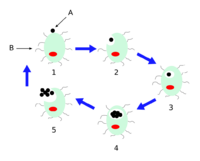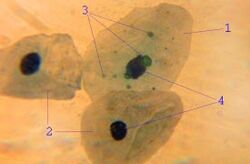Biology:Chlamydia pneumoniae
| Chlamydia pneumoniae | |
|---|---|
| Scientific classification | |
| Kingdom: | |
| Phylum: | |
| Order: | |
| Family: | |
| Genus: | |
| Species: | C. pneumoniae[1]
|
Chlamydia pneumoniae is a species of Chlamydia, an obligate intracellular bacterium[2] that infects humans and is a major cause of pneumonia. It was known as the Taiwan acute respiratory agent (TWAR) from the names of the two original isolates – Taiwan (TW-183) and an acute respiratory isolate designated AR-39.[3] Briefly, it was known as Chlamydophila pneumoniae, and that name is used as an alternate in some sources.[4] In some cases, to avoid confusion, both names are given.[5]
C. pneumoniae has a complex life cycle and must infect another cell to reproduce; thus, it is classified as an obligate intracellular pathogen. The full genome sequence for C. pneumoniae was published in 1999.[6] It also infects and causes disease in koalas, emerald tree boas (Corallus caninus), iguanas, chameleons, frogs, and turtles.
The first known case of infection with C. pneumoniae was a case of conjunctivitis in Taiwan in 1950. There are no known cases of C. pneumoniae in human history before 1950. This atypical bacterium commonly causes pharyngitis, bronchitis, coronary artery disease and atypical pneumonia in addition to several other possible diseases.[7][8]
Life cycle and method of infection

Chlamydia pneumoniae is a small gram-negative bacterium (0.2 to 1 μm) that undergoes several transformations during its life cycle. It exists as an elementary body (EB) between hosts. The EB is not biologically active, but is resistant to environmental stresses and can survive outside a host for a limited time. The EB travels from an infected person to the lungs of an uninfected person in small droplets and is responsible for infection. Once in the lungs, the EB is taken up by cells in a pouch called an endosome by a process called phagocytosis. However, the EB is not destroyed by fusion with lysosomes, as is typical for phagocytosed material. Instead, it transforms into a reticulate body (RB) and begins to replicate within the endosome. The reticulate bodies must use some of the host's cellular metabolism to complete its replication. The reticulate bodies then convert back to elementary bodies and are released back into the lung, often after causing the death of the host cell. The EBs are thereafter able to infect new cells, either in the same organism or in a new host. Thus, the lifecycle of C. pneumoniae is divided between the elementary body, which is able to infect new hosts but cannot replicate, and the reticulate body, which replicates but is not able to cause a new infection.[9]
Diseases
C. pneumoniae is a common cause of pneumonia around the world; it is typically acquired by otherwise-healthy people and is a form of community-acquired pneumonia. Its treatment and diagnosis are different from historically recognized causes, such as Streptococcus pneumoniae.[10] Because it does not gram stain well, and because C. pneumoniae bacteria is very different from the many other bacteria causing pneumonia (in the earlier days, it was even thought to be a virus), the pneumonia caused by C. pneumoniae is categorized as an "atypical pneumonia".[11]
One meta-analysis of serological data comparing prior C. pneumoniae infection in patients with and without lung cancer found results suggesting prior infection was associated with an increased risk of developing lung cancer.[12][13][14]
In research into the association between C. pneumoniae infection and atherosclerosis and coronary artery disease, serological testing, direct pathologic analysis of plaques, and in vitro testing suggest infection with C. pneumoniae is a significant risk factor for development of atherosclerotic plaques and atherosclerosis.[15] C. pneumoniae infection increases adherence of macrophages to endothelial cells in vitro and aortas ex vivo.[16] However, most current research and data are insufficient and do not define how often C. pneumoniae is found in atherosclerotic or normal vascular tissue.[17]
C. pneumoniae has also been found in the cerebrospinal fluid of patients diagnosed with multiple sclerosis.[18]
C. pneumoniae infection was first associated with wheezing, asthmatic bronchitis, and adult-onset asthma in 1991.[19] Subsequent studies of bronchoalveolar lavage fluid from pediatric patients with asthma and also other severe chronic respiratory illnesses have demonstrated that over 50 percent had evidence of C. pneumoniae by direct organism identification.[20][21] C. pneumoniae infection triggers acute wheezing, if it becomes chronic then it is diagnosed as asthma.[22] These observations suggest that acute C. pneumoniae infection is capable of causing protean manifestations of chronic respiratory illness which lead to asthma.
Macrolide antibiotic treatment can improve asthma in a subgroup of patients that remains to be clearly defined. Macrolide benefits were first suggested in two observational trials[23][24] and two randomized controlled trials[25][26] of azithromycin treatment for asthma. One of these RCTs[26] and another macrolide trial[27] suggest that the treatment effect may be greatest in patients with severe, refractory asthma. These clinical results correlate with epidemiological evidence that C. pneumoniae is positively associated with asthma severity[28] and laboratory evidence that C. pneumoniae infection creates steroid-resistance.[29] A meta analysis of 12 RCTs of macrolides for the long term management of asthma found significant effects on asthma symptoms, quality of life, bronchial hyper reactivity and peak flow but not FEV1.[30] More recent positive results of long-term treatment with azithromycin on asthma exacerbations and quality-of-life in patients with severe, refractory asthma[31][32] have resulted in azithromycin now being recommended in international guidelines as a treatment option for these types of patients.[33]
A recent case series of 101 adults with asthma reported that macrolides (mostly azithromycin) and tetracyclines, either separately or in combination, appeared to be dramatically efficacious in a subgroup of "difficult-to-treat" (i.e., not necessarily refractory to high-dose inhaled corticosteroids but who did not take them) patients with severe asthma, many of whom also had the "overlap syndrome" (asthma and COPD).[34] Randomized, controlled trials that include these types of asthma patients are needed.
C. pneumoniae infection is also associated with schizophrenia. Many other pathogens have been associated with schizophrenia.[35]
Vaccine research
There is currently no vaccine to protect against Chlamydia pneumoniae. Identification of immunogenic antigens is critical for the construction of an efficacious subunit vaccine against C. pneumoniae infections. Additionally, there is a general shortage worldwide of facilities that can identify/diagnose Chlamydia pneumoniae.
References
- ↑ "Emended description of the order Chlamydiales, proposal of Parachlamydiaceae fam. nov. and Simkaniaceae fam. nov., each containing one monotypic genus, revised taxonomy of the family Chlamydiaceae, including a new genus and five new species, and standards for the identification of organisms". International Journal of Systematic Bacteriology 49 (2): 415–40. April 1999. doi:10.1099/00207713-49-2-415. PMID 10319462.
- ↑ Chlamydia+pneumoniae at the US National Library of Medicine Medical Subject Headings (MeSH)
- ↑ Mayer, Gene (24 June 2010). "Bacteriology - Chapter Twenty: Chlamydia and Chlamydophila". Bacteriology Section of Microbiology and Immunology On-line. University of South Carolina School of Medicine. http://pathmicro.med.sc.edu/mayer/chlamyd.htm.
- ↑ "Chlamydia pneumoniae". Taxonomy Browser. National Center for Biotechnology Information (NCBI), U.S. National Library of Medicine. https://www.ncbi.nlm.nih.gov/Taxonomy/Browser/wwwtax.cgi?mode=Info&id=83558&lvl=3&lin=f&keep=1&srchmode=1&unlock.
- ↑ "Inhibition of apoptosis in neuronal cells infected with Chlamydophila (Chlamydia) pneumoniae". BMC Neuroscience 9: 13. 2008. doi:10.1186/1471-2202-9-13. PMID 18218130.
- ↑ "Comparative genomes of Chlamydia pneumoniae and C. trachomatis". Nature Genetics 21 (4): 385–9. April 1999. doi:10.1038/7716. PMID 10192388.
- ↑ Lang, B. R. (September 15, 1991). "Chlamydia pneumonia as a differential diagnosis? Follow-up to a case report on progressive pneumonitis in an adolescent". Patient Care.
- ↑ Little, Linda (September 19, 1991). "Elusive pneumonia strain frustrates many clinicians". Medical Tribune: 6.
- ↑ "Chlamydial Infections". https://www.lecturio.com/concepts/chlamydial-infections/.
- ↑ "Simultaneous use of direct and indirect diagnostic techniques in atypical respiratory infections from Chlamydophila pneumoniae and Mycoplasma pneumoniae". Journal of Clinical Laboratory Analysis 23 (4): 206–9. 2009. doi:10.1002/jcla.20332. PMID 19623657.
- ↑ Cunha BA (May 2006). "The atypical pneumonias: clinical diagnosis and importance". Clin. Microbiol. Infect. 12 (Suppl 3): 12–24. doi:10.1111/j.1469-0691.2006.01393.x. PMID 16669925.
- ↑ "Chlamydia pneumoniae infection and lung cancer risk: a meta-analysis". European Journal of Cancer 47 (5): 742–7. March 2011. doi:10.1016/j.ejca.2010.11.003. PMID 21194924.
- ↑ "Bacteria and cancer: cause, coincidence or cure? A review". Journal of Translational Medicine 4: 14. 2006. doi:10.1186/1479-5876-4-14. PMID 16566840.
- ↑ "Chlamydia pneumoniae and lung cancer: epidemiologic evidence". Cancer Epidemiology, Biomarkers & Prevention 14 (4): 773–8. April 2005. doi:10.1158/1055-9965.EPI-04-0599. PMID 15824142.
- ↑ "Chlamydia pneumoniae induces nitric oxide synthase and lipoxygenase-dependent production of reactive oxygen species in platelets. Effects on oxidation of low density lipoproteins". Thrombosis and Haemostasis 94 (2): 327–35. August 2005. doi:10.1160/TH04-06-0360. PMID 16113822.
- ↑ "Chlamydia pneumoniae infection increases adherence of mouse macrophages to mouse endothelial cells in vitro and to aortas ex vivo". Infection and Immunity 76 (2): 510–4. February 2008. doi:10.1128/IAI.01267-07. PMID 18070891.
- ↑ "Chlamydia pneumoniae and vascular disease: an update". Journal of Vascular Surgery 43 (6): 1301–7. June 2006. doi:10.1016/j.jvs.2006.02.050. PMID 16765261.
- ↑ "Chlamydia pneumoniae infection of the central nervous system in multiple sclerosis". Annals of Neurology 46 (1): 6–14. July 1999. doi:10.1002/1531-8249(199907)46:1<6::AID-ANA4>3.0.CO;2-M. PMID 10401775.
- ↑ "Association of Chlamydia pneumoniae (strain TWAR) infection with wheezing, asthmatic bronchitis, and adult-onset asthma". JAMA 266 (2): 225–30. July 1991. doi:10.1001/jama.266.2.225. PMID 2056624.
- ↑ "Bronchial Chlamydia pneumoniae infection, markers of allergic inflammation and lung function in children". Pediatric Allergy and Immunology 12 (5): 257–65. October 2001. doi:10.1034/j.1399-3038.2001.00042.x. PMID 11737672.
- ↑ "The bronchial lavage of pediatric patients with asthma contains infectious Chlamydia". American Journal of Respiratory and Critical Care Medicine 171 (10): 1083–8. May 2005. doi:10.1164/rccm.200407-917OC. PMID 15735056.
- ↑ "Can acute Chlamydia pneumoniae respiratory tract infection initiate chronic asthma?". Annals of Allergy, Asthma & Immunology 81 (4): 339–44. October 1998. doi:10.1016/S1081-1206(10)63126-2. PMID 9809498.
- ↑ "Treatment of Chlamydia pneumoniae infection in adult asthma: a before-after trial". The Journal of Family Practice 41 (4): 345–51. October 1995. PMID 7561707. http://go.galegroup.com/ps/anonymous?id=GALE%7CA17527968.
- ↑ "Chlamydia pneumoniae-specific IgE is prevalent in asthma and is associated with disease severity". PLOS ONE 7 (4): e35945. 2012. doi:10.1371/journal.pone.0035945. PMID 22545149. Bibcode: 2012PLoSO...735945H.
- ↑ "Secondary outcomes of a pilot randomized trial of azithromycin treatment for asthma". PLOS Clinical Trials 1 (2): e11. June 2006. doi:10.1371/journal.pctr.0010011. PMID 16871333.
- ↑ 26.0 26.1 "Azithromycin for bronchial asthma in adults: an effectiveness trial". Journal of the American Board of Family Medicine 25 (4): 442–59. 2012. doi:10.3122/jabfm.2012.04.110309. PMID 22773713.
- ↑ "Clarithromycin targets neutrophilic airway inflammation in refractory asthma". American Journal of Respiratory and Critical Care Medicine 177 (2): 148–55. January 2008. doi:10.1164/rccm.200707-1134OC. PMID 17947611.
- ↑ "Chlamydia pneumoniae and severity of asthma". Scandinavian Journal of Infectious Diseases 34 (1): 22–7. 2002. doi:10.1080/00365540110077155. PMID 11874160.
- ↑ "Chlamydia pneumoniae infection enhances cellular proliferation and reduces steroid responsiveness of human peripheral blood mononuclear cells via a tumor necrosis factor-alpha-dependent pathway". Clinical and Experimental Allergy 35 (12): 1625–31. December 2005. doi:10.1111/j.1365-2222.2005.02391.x. PMID 16393329.
- ↑ "Macrolides for the long-term management of asthma--a meta-analysis of randomized clinical trials". Allergy 68 (8): 1040–9. August 2013. doi:10.1111/all.12199. PMID 23895667.
- ↑ Gibson, PG (2017). "Effect of azithromycin on asthma exacerbations and quality of life in adults with persistent uncontrolled asthma (AMAZES): a randomised, double-blind, placebo-controlled trial". Lancet 390 (10095): 659-668. doi:10.1016/S0140-6736(17)31281-3.
- ↑ Gibson, PG (2019). "Efficacy of azithromycin in severe asthma from the AMAZES randomised trial". ERJ Open Res 5 (4). doi:10.1183/23120541.00056-2019.
- ↑ GINA. "Difficult-to-Treat and Severe Asthma in Adolescent and Adult Patients: Diagnosis and Management". https://ginasthma.org/severeasthma/.
- ↑ Wagshul, FA (2021). "Outcomes of Antibiotics in Adults with "Difficult to Treat" Asthma or the Overlap Syndrome". J Asthma Allergy 14: 703-712. doi:10.2147/JAA.S313480.
- ↑ "Infectious agents associated with schizophrenia: a meta-analysis.". Schizophr. Res. 136 (1–3): 128–136. April 2012. doi:10.1016/j.schres.2011.10.026. PMID 22104141.
External links
- Chlamydia Pneumoniae cpnhelp.org
- Type strain of Chlamydopila pneumoniae at BacDive - the Bacterial Diversity Metadatabase
Wikidata ☰ Q132319 entry


